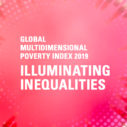
Search
Articles

Editorial – Dimensions Edition 7
We are devoting this edition of Dimensions to the littlest ones, who sadly are the poorest in the world. We begin with an article by Martin Evans, who brings us up to date on the latest in the measurement of child poverty, with a review of existing methodologies and key elements to keep in mind when working to reduce child poverty.



Data Sources for National Multidimensional Poverty Measures
Countries are using different data sources to identify poverty levels and/or deprivations of specific groups. The different data sources have different characteristics, and present advantages and disadvantages that must be weighted by technical teams and policymakers before taking the decision of which data source to use. If there is not but one option, knowing the exact nature of the data source allows designing the best measure given its constraints. The following table, borrowed from the forthcoming handbook from OPHI and UNDP, How to Build a National Multidimensional Poverty Index (MPI): Using the MPI to inform the SDGs, illustrates these differences.

New Version of the Global MPI – Editorial April 2019
In this new edition we present an interview by Sabina Alkire with former President of Colombia and Nobel Peace Prize winner, Juan Manuel Santos. In the conversation, Santos explains the reasons that led him to create the Colombian Multidimensional Poverty Index (MPI) and how it was used to improve the efficiency of social policies.












